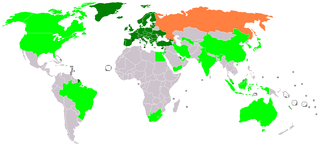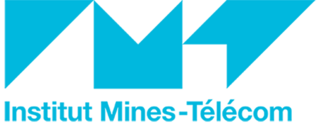 W
WThe Asia Pacific Telecommunity (APT) was founded on the joint initiatives of the United Nations Economic and Social Commission for Asia and the Pacific (UNESCAP), and the International Telecommunication Union (ITU).
 W
WThe Beijing University of Posts and Telecommunications (BUPT) is a key national university distinguished by the teaching and research in the field of cable communications, wireless communications, computer, and electronic engineering. BUPT is ranked as one of the top engineering schools in China under the Project 211. In 2017 the U.S. News & World Report "Best Global Universities" rankings, BUPT is ranked 28th in computer science in the world. BUPT comprises 17 schools, and has an international school program with Queen Mary University of London. It is a Chinese Ministry of Education Double First Class Discipline University, with Double First Class status in certain disciplines.
 W
WThe Broadband Global Area Network (BGAN) is a global satellite network with telephony owned by Inmarsat using portable terminals. The terminals are normally used to connect a laptop computer to broadband Internet in remote locations, although as long as line-of-sight to the satellite exists, the terminal can be used anywhere. The value of BGAN terminals is that, unlike other satellite Internet services which require bulky and heavy satellite dishes to connect, a BGAN terminal is about the size of a laptop and thus can be carried easily. The network is provided by Inmarsat and uses three geostationary satellites called I-4 to provide almost global coverage.
 W
WChongqing University of Posts and Telecommunications is a public university in China's fourth largest municipality: Chongqing. It focuses on the research and education in the field of information and communications and enjoys nationwide reputation in the study of postal communications, telecommunications and information technology, especially for its research and commercialization in 3G mobile technologies, optical sciences and related digital research. It is one of the four universities of Posts and Telecommunications in China and the only one of its kind in the Southwest China. It enjoys a good reputation in the ICT industry in China due to its high quality education and research and the large number of alumni working in the ICT industry. Due to its achievements and contributions in the field of information and communications technology, especially in the development of China's own digital communications systems, CQUPT is considered as the cradle of China's digital communications.
 W
WCTIA is a trade association representing the wireless communications industry in the United States. The association was established in 1984 and is headquartered in Washington, D.C. It is a 501(c)(6) nonprofit membership organization, and represents wireless carriers and suppliers, and manufacturers and providers of wireless products and services.
 W
WThe Ethernet Alliance was incorporated in the US state of California in August 2005 and officially launched in January 2006 as a non-profit industry consortium to promote and support Ethernet. The objectives were to provide an unbiased, industry-based source of educational information; to ensure interoperability among disparate, standards-based components and systems; to support the development of standards that support Ethernet technology; and to bring together the Ethernet industry to collaborate on the future of the technology.
 W
WETSI is an independent, not-for-profit, standardization organization in the field of information and communications. ETSI supports the development and testing of global technical standards for ICT-enabled systems, applications and services.
 W
WThe European Telecommunications Satellite Organization is an intergovernmental organisation consisting of 49 member states. It is headquartered in Paris, France. The mission of EUTELSAT IGO is to maintain the rights to use radio frequencies and orbital locations which were assigned collectively to the Member States by the International Telecommunication Union (ITU) and to oversee the operations of Eutelsat S.A. so as to ensure that the company complies with the international EUTELSAT Convention. EUTELSAT IGO plays an active role within the global telecommunications community and is a key actor in the satellite business sector.
 W
WThe GSM Association is an industry organisation that represents the interests of mobile network operators worldwide. More than 750 mobile operators are full GSMA members and a further 400 companies in the broader mobile ecosystem are associate members. The GSMA represents its members via industry programmes, working groups and industry advocacy initiatives.
 W
WThe Huichon University of Telecommunications is located in Huichon, Chagang, North Korea, founded on September 1, 1959.
 W
WThe INOC-DBA hotline phone system is a global voice telephony network deployed and managed by Packet Clearing House that connects the network operations centers and security incident response teams of critical Internet infrastructure providers such as backbone carriers, Internet service providers, and Internet exchanges as well as critical individuals within the policy, regulatory, Internet governance, security and vendor communities.
 W
WInstitut Mines-Télécom (IMT) is a French public academic institution dedicated to Higher Education and Research for Innovation in the fields of engineering and digital technology, organized as a Collegiate University. Created in 1996, it was originally known as the "Groupe des écoles des télécommunications", or GET, followed by the "Institut Télécom". The Mines schools, which were placed under the administrative supervision of the Ministry of Industry, joined the Institut in March 2012 when it took on its current name and gained the status of Grand établissement. it combines high academic and scientific legitimacy with a practical proximity to business and a unique positioning in 3 major transformations of the 21st century: Digital Affairs, Energy and Ecology, and Industry. Its training and research for innovation are rolled out in the Mines and Télécom Graduate Schools. The Institut falls under the administrative aegis of the General Council for the Economy, Industry, Energy and Technologies.
 W
WThe Mobile Manufacturers Forum is an international non-profit organization founded in 1998 by a number of leading manufacturers of mobile radio equipment, including Alcatel, Ericsson, Mitsubishi Electric, Motorola, Nokia, Karbonn Mobiles, Panasonic, Philips, Sagem, Samsung, Siemens, Sony Ericsson and TCL & Alcatel Mobile Phones.
 W
WThe Next Generation Mobile Networks (NGMN) Alliance is a mobile telecommunications association of mobile operators, vendors, manufacturers and research institutes. It was founded by major mobile operators in 2006 as an open forum to evaluate candidate technologies to develop a common view of solutions for the next evolution of wireless networks. Its objective is to ensure the successful commercial launch of future mobile broadband networks through a roadmap for technology and friendly user trials. Its office is in Frankfurt, Germany.
 W
WThe Open Handset Alliance (OHA) is a consortium of 84 firms to develop open standards for mobile devices. Member firms include HTC, Sony, Dell, Intel, Motorola, Qualcomm, Texas Instruments, Google, Samsung Electronics, LG Electronics, T-Mobile, Sprint Corporation, Nvidia, and Wind River Systems.
 W
WThe PTCRB was established in 1997 as the certification forum by select North American cellular operators. Now a pseudo-acronym, it no longer stands for its original meaning of the PCS Type Certification Review Board.
 W
WSailfish OS is a Linux-based operating system based on open source projects such as Mer and including a closed source UI. The project is being developed by the Finnish company Jolla.
 W
WThe Telecommunications Industry Association (TIA) is accredited by the American National Standards Institute (ANSI) to develop voluntary, consensus-based industry standards for a wide variety of Information and Communication Technologies (ICT) products, and currently represents nearly 400 companies. TIA's Standards and Technology Department operates twelve engineering committees, which develop guidelines for private radio equipment, cellular towers, data terminals, satellites, telephone terminal equipment, accessibility, VoIP devices, structured cabling, data centers, mobile device communications, multimedia multicast, vehicular telematics, healthcare ICT, machine to machine communications, and smart utility networks.
 W
WThe Telecommunications Research Establishment (TRE) was the main United Kingdom research and development organization for radio navigation, radar, infra-red detection for heat seeking missiles, and related work for the Royal Air Force (RAF) during World War II and the years that followed. It was regarded as "the most brilliant and successful of the English wartime research establishments" under "Rowe, who saw more of the English scientific choices between 1935 and 1945 than any single man."
 W
WTélécoms Sans Frontières (TSF) is an emergency technology non-governmental organization, which intervenes in the context of humanitarian crises, conflict zones and areas hit by natural disasters to set up satellite communication for the affected populations and humanitarian organisations.
 W
W